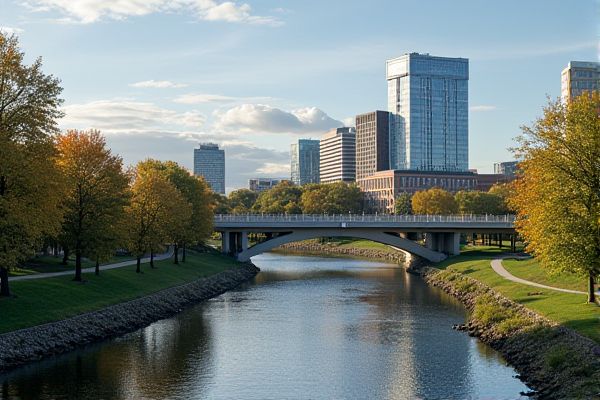
Internet and telecommunications options in Maryland: Availability of high-speed internet providers. Popular telecommunications companies. Fiber-optic internet access. Satellite internet options. Mobile network coverage quality. Internet bundling packages. Average internet speed in Maryland. Contract vs. no-contract plans. Rural vs. urban internet access. Public Wi-Fi availability and locations.
Availability of high-speed internet providers
In Maryland, high-speed internet is widely available through providers like Verizon, Xfinity, and T-Mobile. Verizon offers fiber-optic networks up to 940 Mbps, while Xfinity provides cable networks reaching speeds up to 3,000 Mbps, effectively covering significant portions of the state. For more detailed information on local options, visit Allconnect, which offers comprehensive details on the internet services available in your area.
Popular telecommunications companies
In Maryland, prominent telecommunications companies include Ciena, Hughes, and Verizon Maryland LLC, offering a range of services such as 5G and mobile networking, broadband solutions, fiber-optic networks, and managed network services. Other notable companies include Atlantech Online, MidAtlanticBroadband, Inc., and Advanced Communications Technology, each providing specialized telecommunications infrastructure and services. For a comprehensive overview, visit the Top Telecommunications Companies in the region.
Fiber-optic internet access
In Maryland, particularly in Baltimore, fiber-optic internet access is primarily provided by Verizon Fios and EarthLink Fiber. Verizon Fios offers widespread coverage with speeds up to 2 Gbps, symmetrical upload and download speeds, and no data caps, starting at $34.99 per month. EarthLink Fiber, though with limited coverage of 12.6% of the city, offers speeds up to 5 Gbps starting at $54.95 per month.
Satellite internet options
In Maryland, satellite internet options include Starlink, HughesNet, and Viasat, which offer service to households with limited or no other internet options. Although these services often have slower speeds and higher costs compared to other types of internet connections, they provide an essential service for remote areas. For more details on choosing the best internet service in Maryland, you can visit the comprehensive guide on Internet Providers in Maryland. Satellite options serve as a valuable alternative when traditional internet infrastructure is not available.
Mobile network coverage quality
In Maryland, AT&T boasts the best mobile network coverage, reaching approximately 97.7% of the state's zip codes and 99.92% of homes with both 4G and 5G services. T-Mobile and Verizon are close contenders, with T-Mobile covering 96.05% of the area and Verizon covering 88.64%. Despite these variations, all major carriers offer robust coverage throughout the state. For more detailed information, visit the Best Coverage Guide for Maryland.
Internet bundling packages
In Maryland, internet bundling packages can offer significant savings, such as Xfinity's lower-cost introductory plans, and Verizon's discounts when bundling home internet with a phone plan. To explore detailed options and make informed decisions, you can visit the Best Internet Providers in Maryland guide, which provides insights into available bundles and offers. With options like a 100Mbps 5G plan reduced to $35 monthly when bundled, these deals are certainly worth considering for Maryland residents looking to optimize their internet and phone service costs.
Average internet speed in Maryland
Maryland has the fastest average Internet speed in the US, with an average speed of 506.7 Mbps, making it one of the top states for Internet connectivity. For more information about internet speeds and how different states compare, you can visit the Average Internet Speed by State page on WiseVoter's website. This high-speed connectivity is significant for residents and businesses alike, promoting efficient online experiences and robust digital engagement.
Contract vs. no-contract plans
In Maryland, Internet providers offer a mix of contract and no-contract plans. T-Mobile 5G Home Internet stands out for its simplicity with month-to-month contracts and no long-term commitments, while other providers like Verizon Fios and Xfinity may require contracts or offer better rates with promotional periods that can lead to price hikes after the initial term.
Rural vs. urban internet access
In Maryland, there is a significant disparity between rural and urban internet access, with 5.2% of rural residents lacking access to 25 Mbps/3 Mbps internet compared to 2.0% of urban residents. Rural areas, such as Garrett and Allegany Counties, have the least available access. To address this issue and promote connectivity, initiatives are underway to improve infrastructure and ensure equitable access across the state. For more information on this ongoing effort, you can visit the Maryland Farm Bureau website.
Public Wi-Fi availability and locations
Baltimore City is enhancing digital access by offering free public Wi-Fi through the FreeBmoreWiFi initiative at various locations such as recreation centers, select neighborhoods, and senior centers. Residents can easily find available hotspots using an interactive map and can get technical support via the Marylanders Online Call Center and NPower Community Helpdesk. Similarly, the Enoch Pratt Free Library extends its services with free Wi-Fi through mobile outreach vehicles and select library locations, allowing access even without a library card. In addition, Baltimore County has significantly widened its free Wi-Fi reach to over 200 facilities, including recreation and park locations, public libraries, senior centers, and schools. This expansion comes with an interactive map that helps users to find both current and future [Wi-Fi Locations](https://www.baltimorecountymd.gov/departments/information-technology/wifi-locations). Collectively, these initiatives are pivotal in bridging the digital divide and ensuring residents have access to essential online services.
